Understand Bitcoin network consensus and time synchronization
The Bitcoin network is a decentralized system that is based on the collective agreement of all nodes in order to validate transactions and create new blocks. As with every distributed system, however, there is challenges when reaching the consensus between nodes that work independently. An essential aspect of this problem is time synchronization.
In this article we will deal with several nodes that start at different points, affect the Bitcoin network consensus process, especially when it comes to the mining process and the creation of new blocks.
Several nodes start at different points: a critical problem
If several nodes work on the Bitcoin blockchain at the same time, you may be able to interfere with the consensus process of the network. The main concern is that if two or more nodes find a valid block before another knot finds one, possibly claim to be the author of this block.
For example, imagine two nodes, the node A and the knot B, both connected to a central mining pool. Both knots find blocks independently of each other, but their discoveries occur at slightly different times, since the delays between network cladding and node compounds. If the node A finds a valid block in front of knot B, the claim of node B is denied by the community.
This can lead to a situation in which several forks appear, with each fork creating a new version of the Bitcoin blockchain (a “fork”). The resulting chain branches at different times from the original Bitcoin blockchain. This phenomenon is known as a “block fork” or “chain layout”.
simultaneous mining and block creation
The ability to dismantle blocks at the same time is facilitated by the design of the Bitcoin protocol. When a new block is created, it contains a unique hash that connects it to a previously dismantled block. The process of finding this hash on other knots depends on the fact that all nodes agree to the current status of the blockchain.
If several nodes are broken down at the same time, they essentially compete for the same valid hash. This can lead to the simultaneous discoveries of blocks and subsequent disputes about who found them first.
Time synchronization: a key factor in the network consensus

In order to mitigate the effects of simultaneous mining and block creation, Bitcoin’s network is based on a mechanism that is referred to as “time synchronization”. Essentially, each knot maintains its own local watch, which is synchronized with other knots via a peer-to-peer communication channel.
The idea is that as long as you agree to a common time standard (i.e. your watches are synchronized), you can properly check and validate transactions. In the case of Bitcoin, this means that the local clock should match each node with the current block time (which is normally 10 minutes).
Time synchronization between knot
The question remains: If several nodes start at different times, do we have to synchronize them so that they work on the same clock? The answer is in the design of the Bitcoin protocol.
When a knot finds a valid block, he sends his discovery to all other participating nodes. These knots then synchronize their local watches together and update their own blocks accordingly. This process ensures that all nodes have agreed to the current status of the blockchain.
How knots keep the time synchronization
In order to maintain time synchronization, the Bitcoin network uses several mechanisms:
- Heart strikes : Each knot sends periodic heartbeats (approx. Every 10 minutes) to confirm that it is still online and has not been separated from the network.
- Block verification : When a new block is created, the miner checks his validity by checking whether all knots have synchronized their watches.
- node reconnection : If the connection of a node to the network is lost or separated, it regularly sends a heartbeat to restore communication.